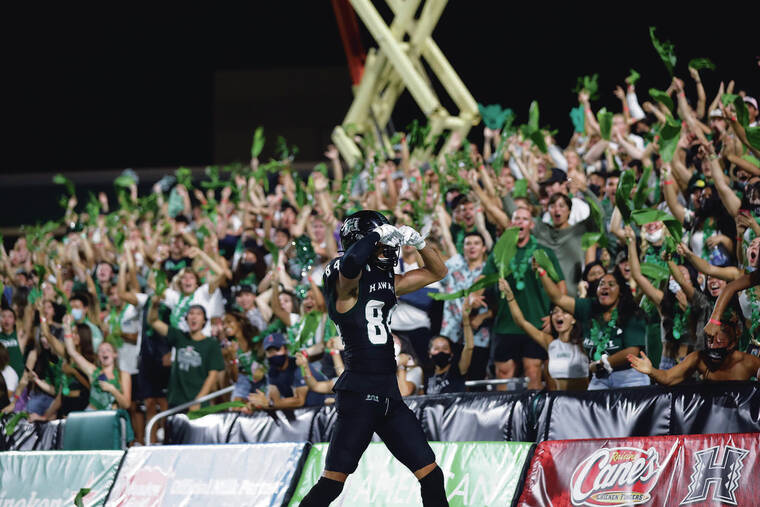The power structure of college football has changed in recent years. Players have more leverage than ever before and coaches need to adapt.
If you don’t believe this, you haven’t been paying much attention to the University of Hawaii program, especially the events of the past week.
Normally, the announcement that Hawaii made it to a bowl game for a school-record fourth year in a row would be cause for celebration, right?
Well, not quite. At least not yet.
These are not normal times for this team, and they are not happy times.
Maybe things will change as we get closer to UH’s Christmas Eve date with Memphis in the EasyPost Hawaii Bowl.
But it will be bittersweet at best.
Notable by their absence from the Hawaii roster will be three starters; quarterback Chevan Cordeiro, running back Dae Dae Hunter and defensive back Cameron Lockridge.
All three missed several games due to injury this season, but that’s not why they’re out. The reason is that they entered the transfer portal.
And, no, they can’t pull themselves out, at least not in time to suit up for the bowl game — even if they wanted to and assuming UH could and would let them. Being in the transfer portal means you have put yourself out there to be recruited by other schools.
This would be a big story anyway, but it got bigger because of another aspect of technology that has empowered student-athletes: social media.
Four days after UH blew up Wyoming 38-14 in its regular-season finale, the Warriors blew up the internet — and not in a good way, at least in the short term.
On Wednesday, spurred by Cordeiro’s announcement, former UH players Darryl McBride Jr. and RJ Hollis hosted an open conversation on Twitter Spaces about the Warriors program. It became a litany of complaints about head coach Todd Graham and some assistants — many coming from current players. Only a few now on the roster participated in the conversation, but around 30 or 40, including Cordeiro and many other starters, attended at least part of the session, Hollis said.
“What the forum was intended to be changed when the players showed up,” Hollis, who works as an analyst for UH football telecasts, said in a phone interview. “It was not meant to be an attack space of any kind and there was never any pressure for any statement to be made. We didn’t know the (players) were going to be there, or what they were going to say until they said it.”
The complaints are the usual kind you hear about with losing football teams: favoritism, inadequate coaching, an air of intimidation and inflexibility — all of which can lead to overall bad morale.
Yes, even though the Warriors got into a bowl game, they’re still a losing team right now at 6-7. And if you show me a losing college football team, I’ll show you at least 50 unhappy football players.
That’s universal, and it’s always been that way. But there are some striking differences because this is Hawaii, and because this is 2021.
Cordeiro is as loyal to his home state as anyone I’ve ever met. He’s the consummate local guy. For him to decide to leave, things must be pretty bad. This was his fourth year as a Rainbow Warrior with two more to go, and he was a co-captain.
He’s quiet by nature. But you could tell by his body language after one of several close losses, the one to San Diego State, that something was amiss. No one expects anyone to be warm and fuzzy after a defeat, but I’d been at press conferences with Cordeiro after losses before and this was a different guy. This time he said the right words about learning from it and pushing forward, but there was not the usual sense of optimism that he’d always projected before.
UH now runs a very different offense than the run-and-shoot that Cordeiro mastered at Saint Louis School and in his first two years of college. So, there is that. But there must be more.
The fact that you no longer have to sit out a year after transferring makes it a much easier move. Regardless, I don’t think any of the players made this decision on a whim, and I don’t fault anyone for getting themselves out of what they perceive as a toxic environment.
But is the morale really that bad or was the Twitter session just a bunch of gripes from bench warmers? Well, keep in mind that Cordeiro, Hunter and Lockridge are star players, and they have voted with their feet.
Hollis knows what it’s like to be in an unhappy locker room; he was on Norm Chow’s last team. And he knows what it’s like to be on a 6-7 team that goes to a bowl game; he was on Nick Rolovich’s first team.
Hollis said Rolovich was a good communicator who was attentive and responsive to everyone involved in the program. Those are two of the complaints about Graham.
In comments in response to Wednesday’s criticism, Graham said he doesn’t have a Twitter account.
Yes, I know it’s probably better to have a job than a social media presence. But Rolovich did understand that being in the digital spaces where young people spend a lot of time has become an important part of the coaching game.
“It’s not what (Graham’s) doing on the field that’s a problem,” Hollis said. “The problem is that from what he says, it seems like he doesn’t see there’s a morale problem.
“If the players had told us that Todd Graham was an awesome man and an awesome coach, that’s what the narrative would be,” Hollis added. “But that’s not what happened.”

